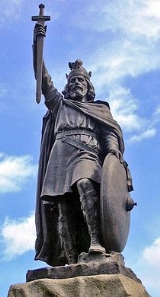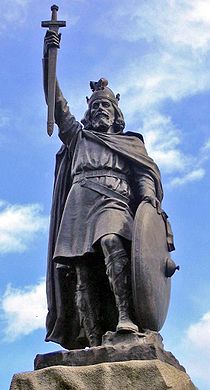
Treaty of Wedmore
Encyclopedia
The Peace of Wedmore is a term used by historians for an event referred to by the monk Asser
in his Life of Alfred, outlining how in 878
the Viking
leader Guthrum
was baptised
and accepted Alfred
as his adoptive father. Guthrum agreed to leave Wessex and a "Treaty of Wedmore" (sometimes called the "Treaty of Chippenham") is often assumed by historians to have existed. No such treaty still exists. However, there is a document not specifically linked to Wedmore that is a Treaty of Alfred and Guthrum
.

defeated a Viking
army at the Battle of Ethandun. Guthrum
, the Viking leader, retreated with the remnants of his army to their "stronghold", where Alfred besieged him. After fourteen days the Vikings "thoroughly terrified by hunger, cold and fear" sought peace and sent an emissary to Alfred.
Alfred accepted Guthrum's surrender. According to Asser
, in his Life of Alfred, the Vikings gave Alfred peace hostages, and "swore in addition that they would leave his kingdom immediately, and Guthrum, their king, promised to accept Christianity
and to receive baptism at King Alfred's hand; all of which he and his men fulfilled as they had promised."
Three weeks later Guthrum and thirty of his men came to Alfred at Aller
, near Athelney
, and there Guthrum was baptised, with Alfred accepting him as his adoptive son. Then, according to Asser:
As agreed Guthrum left Chippenham and moved to Cirencester. Following this Guthrum returned to East Anglia
, where he ruled in what had been East Anglia, Essex
and Eastern Mercia
. Over time these lands became known as Danelaw
. Eventually Wessex
, under Alfred and his successors, conquered all of this land.
However, some misinterpretation appears to have arisen, probably from confusing what happened at Wedmore with the later Treaty of Alfred and Guthrum
. This led to a "Treaty of Wedmore" as a defining point in Anglo-Saxon history, as suggested by the map. Whilst it is quite possible that land arrangements were discussed at Wedmore, or Aller, or elsewhere, following Ethandun, there is nothing in the sources to provide evidence for this.
Asser
Asser was a Welsh monk from St David's, Dyfed, who became Bishop of Sherborne in the 890s. About 885 he was asked by Alfred the Great to leave St David's and join the circle of learned men whom Alfred was recruiting for his court...
in his Life of Alfred, outlining how in 878
878
Year 878 was a common year starting on Wednesday of the Julian calendar.- Europe :...
the Viking
Viking
The term Viking is customarily used to refer to the Norse explorers, warriors, merchants, and pirates who raided, traded, explored and settled in wide areas of Europe, Asia and the North Atlantic islands from the late 8th to the mid-11th century.These Norsemen used their famed longships to...
leader Guthrum
Guthrum the Old
Guthrum , christened Æthelstan, was King of the Danish Vikings in the Danelaw. He is mainly known for his conflict with Alfred the Great.-Guthrum, founder of the Danelaw:...
was baptised
Baptism
In Christianity, baptism is for the majority the rite of admission , almost invariably with the use of water, into the Christian Church generally and also membership of a particular church tradition...
and accepted Alfred
Alfred the Great
Alfred the Great was King of Wessex from 871 to 899.Alfred is noted for his defence of the Anglo-Saxon kingdoms of southern England against the Vikings, becoming the only English monarch still to be accorded the epithet "the Great". Alfred was the first King of the West Saxons to style himself...
as his adoptive father. Guthrum agreed to leave Wessex and a "Treaty of Wedmore" (sometimes called the "Treaty of Chippenham") is often assumed by historians to have existed. No such treaty still exists. However, there is a document not specifically linked to Wedmore that is a Treaty of Alfred and Guthrum
Treaty of Alfred and Guthrum
The Treaty of Alfred and Guthrum is an agreement between Alfred of Wessex and Guthrum, the Viking ruler of East Anglia. Its date is uncertain, but must have been between 878 and 890. The treaty is one of the few existing documents of Alfred's reign; it survives in Old English in Corpus Christi...
.

Sources and historical context
In 878 King Alfred of WessexAlfred the Great
Alfred the Great was King of Wessex from 871 to 899.Alfred is noted for his defence of the Anglo-Saxon kingdoms of southern England against the Vikings, becoming the only English monarch still to be accorded the epithet "the Great". Alfred was the first King of the West Saxons to style himself...
defeated a Viking
Viking
The term Viking is customarily used to refer to the Norse explorers, warriors, merchants, and pirates who raided, traded, explored and settled in wide areas of Europe, Asia and the North Atlantic islands from the late 8th to the mid-11th century.These Norsemen used their famed longships to...
army at the Battle of Ethandun. Guthrum
Guthrum the Old
Guthrum , christened Æthelstan, was King of the Danish Vikings in the Danelaw. He is mainly known for his conflict with Alfred the Great.-Guthrum, founder of the Danelaw:...
, the Viking leader, retreated with the remnants of his army to their "stronghold", where Alfred besieged him. After fourteen days the Vikings "thoroughly terrified by hunger, cold and fear" sought peace and sent an emissary to Alfred.
Alfred accepted Guthrum's surrender. According to Asser
Asser
Asser was a Welsh monk from St David's, Dyfed, who became Bishop of Sherborne in the 890s. About 885 he was asked by Alfred the Great to leave St David's and join the circle of learned men whom Alfred was recruiting for his court...
, in his Life of Alfred, the Vikings gave Alfred peace hostages, and "swore in addition that they would leave his kingdom immediately, and Guthrum, their king, promised to accept Christianity
Christianity
Christianity is a monotheistic religion based on the life and teachings of Jesus as presented in canonical gospels and other New Testament writings...
and to receive baptism at King Alfred's hand; all of which he and his men fulfilled as they had promised."
Three weeks later Guthrum and thirty of his men came to Alfred at Aller
Aller, Somerset
Aller is a village and parish in Somerset, England, situated west of Somerton on the A372 road towards Bridgwater in the South Somerset district. The village has a population of 374...
, near Athelney
Athelney
Athelney is located between the villages of Burrowbridge and East Lyng in the Sedgemoor district of Somerset, England. The area is known as the Isle of Athelney, because it was once a very low isolated island in the 'very great swampy and impassable marshes' of the Somerset Levels. Much of the...
, and there Guthrum was baptised, with Alfred accepting him as his adoptive son. Then, according to Asser:
- the unbinding of the chrisom on the eighth day took place at a royal estate called WedmoreWedmoreWedmore is a village and civil parish in the county of Somerset, England. It is situated on raised ground, in the Somerset Levels between the River Axe and River Brue, often called the Isle of Wedmore. It forms part of Sedgemoor district...
.
As agreed Guthrum left Chippenham and moved to Cirencester. Following this Guthrum returned to East Anglia
East Anglia
East Anglia is a traditional name for a region of eastern England, named after an ancient Anglo-Saxon kingdom, the Kingdom of the East Angles. The Angles took their name from their homeland Angeln, in northern Germany. East Anglia initially consisted of Norfolk and Suffolk, but upon the marriage of...
, where he ruled in what had been East Anglia, Essex
Essex
Essex is a ceremonial and non-metropolitan county in the East region of England, and one of the home counties. It is located to the northeast of Greater London. It borders with Cambridgeshire and Suffolk to the north, Hertfordshire to the west, Kent to the South and London to the south west...
and Eastern Mercia
Mercia
Mercia was one of the kingdoms of the Anglo-Saxon Heptarchy. It was centred on the valley of the River Trent and its tributaries in the region now known as the English Midlands...
. Over time these lands became known as Danelaw
Danelaw
The Danelaw, as recorded in the Anglo-Saxon Chronicle , is a historical name given to the part of England in which the laws of the "Danes" held sway and dominated those of the Anglo-Saxons. It is contrasted with "West Saxon law" and "Mercian law". The term has been extended by modern historians to...
. Eventually Wessex
Wessex
The Kingdom of Wessex or Kingdom of the West Saxons was an Anglo-Saxon kingdom of the West Saxons, in South West England, from the 6th century, until the emergence of a united English state in the 10th century, under the Wessex dynasty. It was to be an earldom after Canute the Great's conquest...
, under Alfred and his successors, conquered all of this land.
Misinterpretation and confusion
The only reference in the sources to any kind of treaty at Wedmore is the above quote from Asser. All we know, therefore, is that it was at Wedmore that Guthrum accepted Alfred as his adoptive father and accepted the Christian faith. There was clearly an important element here of Alfred exercising his dominance; however, the source material provides no hint as to the wider implications of this in terms of territory or otherwise.However, some misinterpretation appears to have arisen, probably from confusing what happened at Wedmore with the later Treaty of Alfred and Guthrum
Treaty of Alfred and Guthrum
The Treaty of Alfred and Guthrum is an agreement between Alfred of Wessex and Guthrum, the Viking ruler of East Anglia. Its date is uncertain, but must have been between 878 and 890. The treaty is one of the few existing documents of Alfred's reign; it survives in Old English in Corpus Christi...
. This led to a "Treaty of Wedmore" as a defining point in Anglo-Saxon history, as suggested by the map. Whilst it is quite possible that land arrangements were discussed at Wedmore, or Aller, or elsewhere, following Ethandun, there is nothing in the sources to provide evidence for this.
External links
- Britannia History Peace of Wedmore

